North Sumatra
Sumatra is the sixth largest island in the world, and anyone visiting it quickly realizes that they must often severely reduce the number of sites they had planned to see while on it. It’s just so big, and the roads are often so bad, that getting from point to point takes a full day plus usually at least half a day of recovery. A 60 km ride will usually take around 5 hours on a bumpy, twisting, potholed road, so most travelers must pick just a section of the island to do. I pick the North.
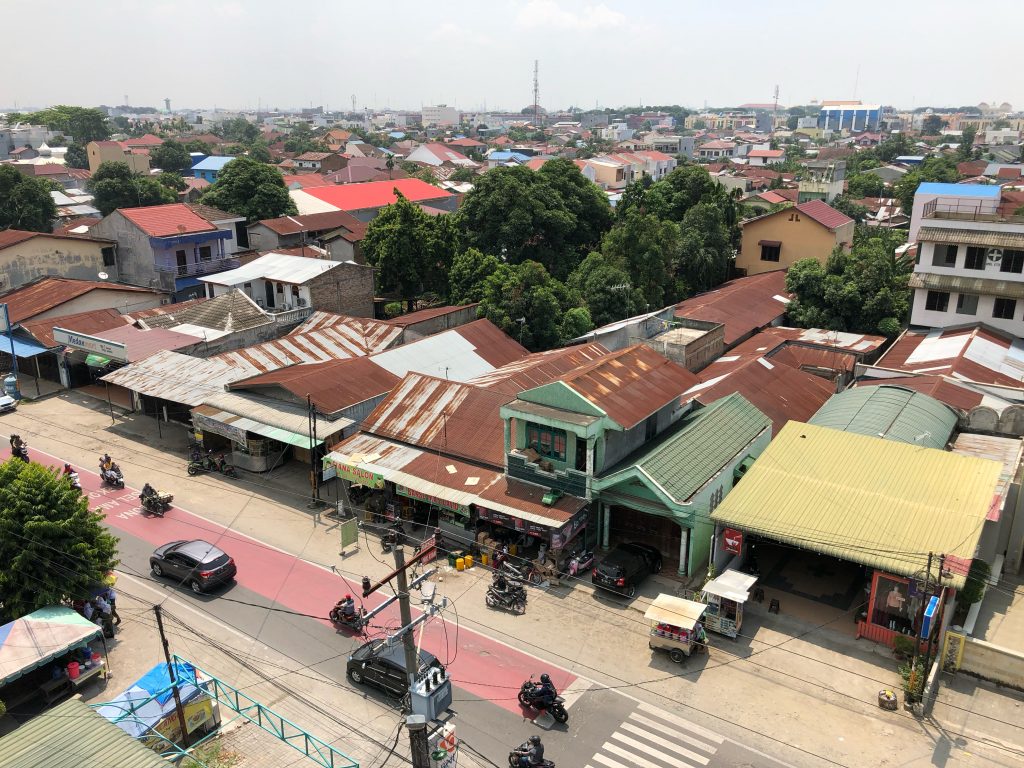
Medan, Sumatra, Indonesia
The gateway to the North is the city of Medan. With more than two million people living in its traffic choked streets, Medan is the biggest and busiest city of Sumatra. I’m not looking forward to Medan, as I’ve heard it’s an example of a bad Southeast Asian city: pollution, traffic, and dirty. So when I arrive that’s all I see. My guesthouse, recommended to me by an online acquaintance, looks squalid and dilapidated. My room is a small, simple box with a mattress on the floor and dirty lime green walls. I remember lying on the mattress upon my arrival, wondering what the hell I was doing in a place like this — a person who uses a paper towel to open bathroom doors in public places.

Motorized becak
It’s early in the evening though, so I have to go out and find food and look around Medan. The guesthouse has a small restaurant so I tuck myself into a rickety plastic chair and order dinner. After I finish I sit thinking what I am going to do from then until I fall asleep not at all excited about the prospects. Then a girl who works in the guesthouse starts talking to me. It’s the first conversation I’ve had with a Sumatran, other than becak drivers (BEE-chak, a motorbike with an attached sidecar found throughout Sumatra). We talk about where I’ve been, who I’ve met, and what my plans are. After several hours of talking she gets her friend to take me out to buy a bus ticket to Ketambe, my next destination.
The ride is free, plus free chit chat with the driver who also speaks English. The difference between this and the other places I’ve been in Indonesia is staggering. Usually nothing is free, especially transport, and yet I’m getting a free motorbike ride and learning about the life of a Sumatran in “big” Medan.
We get to an area with a few bus terminals and have to walk around to each one asking if they go to Ketambe. There aren’t signs with any information anywhere so we’re pointed toward places and people who might have the information we need until we end up at the right place. And along the way I get a taste of a few fruits and nuts that people are standing around eating. Again, I’m amazed: they’re not trying to sell me anything — they’re just sharing a little food and helping us out.

Bika Ambon
After we get the ticket we find a good cake shop. I was told not to miss out on bika ambon, the thick and heavy cake Medan is known for, kind of like a sponge cake but much more dense. This is again a word of mouth trip as my guide asks for a good shop nearby (we’re at least an hour from our starting point and the driver isn’t familiar with the area) and we’re slowly led to a little shop down an alleyway run by a load of young Muslim girls and I get a heavy heavy cake and take it back to the guesthouse to share. This is where I meet the only white person I see while in Medan: a 35 year old English teacher from Nebraska who has been living in Southeast Asia since he was 20. He tells me about the more violent days in Medan when he’d have to take the long way home because the road was blocked by youths fighting one another with machetes and boards with nails in them. This seemed to be more of an annoyance than anything, even to the youths fighting. This violence has been over for several years, he said. You wouldn’t think such friendly people are prone to such violence, as I was only greeted with warmth and interest.
You may have heard of the province of Aceh, and most likely it was not good news you heard. I’ll touch on the fighting later, but Aceh is my next stop — Ketambe is barely within the borders of Aceh in the south. It’s a tiny village that saw its heyday of tourism end about 5 years ago. It’s located right next to Gunung Leuser National Park, a huge protected area which is among the last homes to many orangutan.
 When violence got worse in Aceh (though mostly contained in the North) and the tsunami hit and after extremists bombed Bali, Indonesian tourism dropped dramatically and Sumatran tourism all but vanished. Which is why, when I reach Kutacane, a small city south of Ketambe where I must catch a bus for my last leg, I am stared at as though I have two heads and four fingers growing off both my chins.
When violence got worse in Aceh (though mostly contained in the North) and the tsunami hit and after extremists bombed Bali, Indonesian tourism dropped dramatically and Sumatran tourism all but vanished. Which is why, when I reach Kutacane, a small city south of Ketambe where I must catch a bus for my last leg, I am stared at as though I have two heads and four fingers growing off both my chins.
I jump in the back of a truck with the locals. No one even attempts to lead me to the more expensive tourist vehicles because such things do not exist here. The truck has two benches down either side and a roof. Between me and tittering Muslim school girls is a 30 gallon barrel of gasoline, and beside me is a young Sumatran staring at the Westerner as he holds his cigarette over the barrel. The younger boys hop on the roof. The guy in charge of signaling to the driver to stop who also helps people on and off the truck and collects the money clings to the back as loud dance music bursts through the speaker sitting next to my knees. The speakers rock back and forth as we blast around turns and come to screeching halts for passengers. This, my friends, is Sumatra by bus.
The guesthouse I stay at in Ketambe is owned by an ex-forest ranger named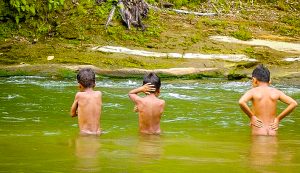 Pak Mus who lost his job along with all the other rangers during the waning of tourism. You may ask why someone would decide to open a guesthouse after he loses his job due to lack of tourism. Don’t. The question of why rarely has a satisfactory answer. He pulls me off the truck with smiles and handshakes and leads me up to his place for tea. The business of taking me to my bungalow and signing me in is postponed for the act of tea drinking and mingling. He has 8 children, two of whom have left home, the rest of whom help run the guesthouse along with his wife. We sit talking for about an hour on his porch in the jungle. Only Pak Mus and his wife speak
Pak Mus who lost his job along with all the other rangers during the waning of tourism. You may ask why someone would decide to open a guesthouse after he loses his job due to lack of tourism. Don’t. The question of why rarely has a satisfactory answer. He pulls me off the truck with smiles and handshakes and leads me up to his place for tea. The business of taking me to my bungalow and signing me in is postponed for the act of tea drinking and mingling. He has 8 children, two of whom have left home, the rest of whom help run the guesthouse along with his wife. We sit talking for about an hour on his porch in the jungle. Only Pak Mus and his wife speak
English but the family and some neighbors are gathered around to check me out.
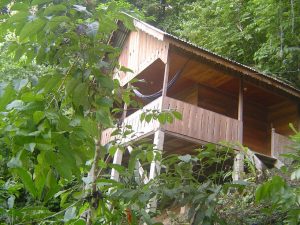 I choose the bungalow located up on the hill. It’s newly finished and is quite a nice hike up which leaves me panting every time I reach it, so I usually have to take a rest in my hammock swinging from the rafters. It’s away from all the other bungalows and is far enough away from the road to keep from hearing any of the minimal amount of traffic that passes by. After I settle in Pak Mus takes me on a ride up into the hills to see monkeys and orangutan. We don’t even need to leave the road to see such creatures — they are right on the side up in the trees.
I choose the bungalow located up on the hill. It’s newly finished and is quite a nice hike up which leaves me panting every time I reach it, so I usually have to take a rest in my hammock swinging from the rafters. It’s away from all the other bungalows and is far enough away from the road to keep from hearing any of the minimal amount of traffic that passes by. After I settle in Pak Mus takes me on a ride up into the hills to see monkeys and orangutan. We don’t even need to leave the road to see such creatures — they are right on the side up in the trees.
We go to see horse races in a town north of Ketambe, a 3 hour ride on a motorbike. The ride is incredible. We wind our way through the hills and most of what we see is beautiful jungle stretching down to the river which rolls through the valley next to us the entire trip. I have no photos of this as I forgot my camera that day, but I really don’t think photos would do it justice. Before we get to the town something breaks on the bike, so we end up missing the horse races. Instead we roll around talking to all of his friends, drinking our weight in tea, and generally relaxing, a practice most people immediately do when company comes through the door no matter what they are doing. Even though nobody really speaks English I’m still able to communicate with them and have a thoroughly enjoyable time.
A further chronological retelling of Ketambe is both boring and unnecessary. So, here are some snapshots.
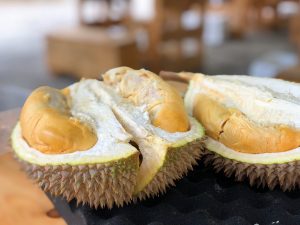 Durian is the best fruit I have ever put in my mouth. You may have heard of it. It’s a favorite fruit throughout Southeast Asia and is known for its distinct odor and surprisingly sharp, spiky exterior. St’s everywhere in Sumatra, sold in piles on the side of the street (outside of the markets due to the pungent smell) and it happens to be in season in Ketambe.
Durian is the best fruit I have ever put in my mouth. You may have heard of it. It’s a favorite fruit throughout Southeast Asia and is known for its distinct odor and surprisingly sharp, spiky exterior. St’s everywhere in Sumatra, sold in piles on the side of the street (outside of the markets due to the pungent smell) and it happens to be in season in Ketambe.
Before it’s opened it smells a bit like anonymous fermenting fruits, and when opened the smell added to this is that of fermenting onions. However when I put it into my mouth I wouldn’t really care if it smelled like manure. A large pit is surrounded by a thin, yellow coating of sweet custard-like flesh. I cannot possibly describe the incredible sweet flavor it has. All I can say is every time I eat it (usually 2 big durian a day) I have to get over the smell with my first bite, and every single time it’s worth it.
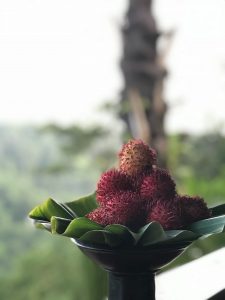
Rambutan
Rambutan is also a favorite fruit here. It’s a little bigger than a golfball, red, with lots of little hairs all over it. You peel the red skin off for a semi-clear flesh surrounding an almond sized pit. The flesh is sweet and addicting if it’s ripe, a bit bitter but still good for a snack if not. Then there’s the snakeskin fruit. I have no idea what it’s called, but that’s how everyone refers to it for obvious reasons. You peel the brown skin off and inside is extremely white extremely dry flesh that is difficult to swallow without a sip of water. Those are the highlights of the fruits, but I could go on for days describing all the fruit I’ve tried for the first time so I’ll leave it at that.
Every morning a monkey greets me on my porch. He’s a small monkey who usually sits on the railing until I open the doors. He looks at me for a little bit, and hops off to find breakfast.
Pak Mus wants me to become Muslim, marry one of his daughters, and take her to America with me. He’s not all that subtle about this, nor about his wish that I buy some land across the street and build a house.
I learn a little Indonesian every day to the delight of the family. Pak Mus’s wife quizzes me each morning on the things I learned on previous days, and while I can’t carry a conversation in Indonesian I can at least order food, greet, and perform business transactions much easier.
I’m welcomed into Pak Mus’s family due to many factors: my wanting to learn Indonesian, my love for durian, and the fact that I’ll eat with my hand like the rest of the families in Indonesia. Rice is the staple food here. Shoveling a handful of rice and meat into your mouth is more fun than you can imagine, especially when it’s the cultural norm.
Every night families in Ketambe gather around the television to watch soap opera-like shows. At any given moment there’s a good chance you’ll see a woman weeping on-screen.
This is as good a place as any to introduce Ramona, the trekking guide. He has brought a family of four to trek into the hills on the same day I’m planning to go trekking with Pak Mus. Ramona reckons electricity is a great thing for people in Sumatra, because then they have something to do at night instead of making more babies to feed. He has a point.
Ramona tells me more than I can here relate about the intricacies of Indonesian life. For instance, while most Indonesian islands want to be their own independent country, the army has taken measures to insure that this is never accomplished. The Indonesian army is huge and powerful, and when a recruit signs up he doesn’t get to stay on his home island where he might start his own little army to induce a revolution, but he is rather sent to another island where he has no ties to the land thus removing his interest in fighting for independence for that place. That’s just one example of the many measures and precautions they take.
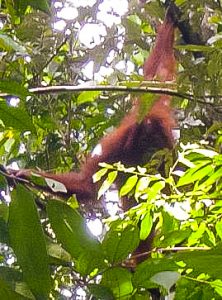 The trek we take is fun, tiring, and leech-infested. Blood covers my shoes from leach bites. We camp out next to a hot spring where I almost burn my foot in the boiling water. I see about 4 orangutan on the trek and am urged/forced by Pak Mus to take photos. I don’t mind taking a photo or two of them, but my camera sucks and I can honestly find better images by better photographers online so I’d rather do just that.
The trek we take is fun, tiring, and leech-infested. Blood covers my shoes from leach bites. We camp out next to a hot spring where I almost burn my foot in the boiling water. I see about 4 orangutan on the trek and am urged/forced by Pak Mus to take photos. I don’t mind taking a photo or two of them, but my camera sucks and I can honestly find better images by better photographers online so I’d rather do just that.
After about a week and a half in Ketambe, Ramona and I leave for Berastagi.
Originally published 27 August, 2007

